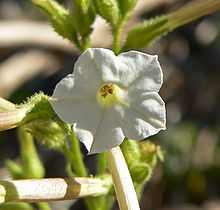- Nicotiana attenuata
-
Nicotiana attenuata 
Scientific classification Kingdom: Plantae (unranked): Angiosperms (unranked): Eudicots (unranked): Asterids Order: Solanales Family: Solanaceae Genus: Nicotiana Species: N. attenuata Binomial name Nicotiana attenuata
Torr. ex S.WatsonNicotiana attenuata is a species of wild tobacco known by the common name coyote tobacco. It is native to western North America from British Columbia to Texas and northern Mexico, where it grows in many types of habitat. It is a glandular and sparsely hairy annual herb exceeding a meter in maximum height. The leaf blades may be 10 centimeters long, the lower ones oval and the upper narrower in shape, and are borne on petioles. The inflorescence bears several flowers with pinkish or greenish white tubular throats 2 to 3 centimeters long, their bases enclosed in pointed sepals. The flower face has five mostly white lobes. The fruit is a capsule about a centimeter long.
This plant was used for a great variety of medicinal purposes by many Native American groups, and was smoked ceremonially by the Hopi, Apache, Navajo, Paiute, and other groups.[1]
When this tobacco is eaten by the larvae of the tobacco hornworm (Manduca sexta) the plant emits green leaf volatiles that attract Geocoris bugs, which are predators of the worm.[2]
References
- ^ Ethnobotany
- ^ Bhanoo, S. From a Desert Plant, a Scented Cry for Help. New York Times August 30, 2010.
External links

This Solanales article is a stub. You can help Wikipedia by expanding it.
